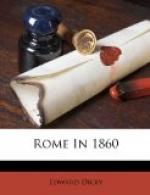Yet surely, if anything of dead Rome be still left in the living city, it should be found in the Roman people. In the Mysteres du Peuple of Eugene Sue, there is a story, that to the Proletarian people, the sons of toil and labour, belong genealogies of their own, pedigrees of families, who from remote times have lived and died among the ranks of industry. These fabulous families, I have often thought, should have had their home in the Eternal City. Amongst the peasants that you meet, praying in the churches, or basking in the sun-light, or toiling in the deadly Campagna plains, there must be some, who, if they knew it, descend in direct lineage from the ancient “Plebs.” It may be so, or rather it must be so; but of the fact there is little outward evidence. You look in vain for the characteristic features of the old Roman face, such as you behold them when portrayed in ancient statues. The broad low brow, the depressed skull, the protruding under-jaw, and the thin compressed lips, are to be seen no longer. Indeed, though I make the remark with the fear of the artist-world before my eyes, I should hardly say myself, that the Romans of the present day were a very handsome race; and of their own type they are certainly inferior both to Tuscans and Neapolitans. The men are well formed and of good height, but not powerful in build or make, and their features are rather marked than regular. As for the women, when you have once perceived that hair may be black as coal and yet coarse as string, that bright sparkling eyes may be utterly devoid of expression, and that an olive complexion may be deepened by the absence of washing, you grow somewhat sceptical as to the reality of their vaunted beauty. All this, however, is a matter of personal taste, about which it is useless to express a decided opinion. I must content myself with the remark, that the Roman peasantry as depicted, year after year, on the walls of our academy, bear about the same resemblance to the article provided for home consumption, as the ladies in an ordinary London ball-room bear to the portraits in the “Book of Beauty.” The peasants’ costumes too, like the smock-frocks and scarlet cloaks of Old England, are dying out fast. On the steps in the “Piazza di Spagna,” and in the artists’ quarter above, you see some score or so of models with the braided boddices, and the head-dresses of folded linen, standing about for hire. The braid, it is true, is torn; the snow-white linen dirt-besmeared, and the brigand looks feeble and inoffensive, while the hoary patriarch plays at pitch and toss: but still they are the same figures that we know so well, the traditional Roman peasantry of the “Grecian” and the “Old Adelphi.” Unfortunately, they are the last of the Romans. In other parts of the city the peasants’ dresses are few and far between; the costume has become so uncommon, as to be now a fashionable dress for the Roman ladies at Carnival time and other holiday festivals.




